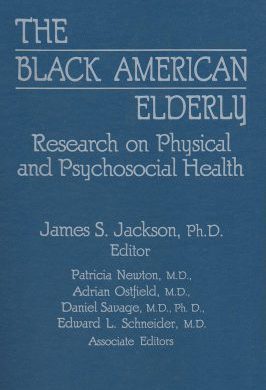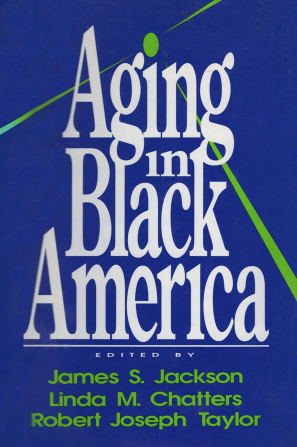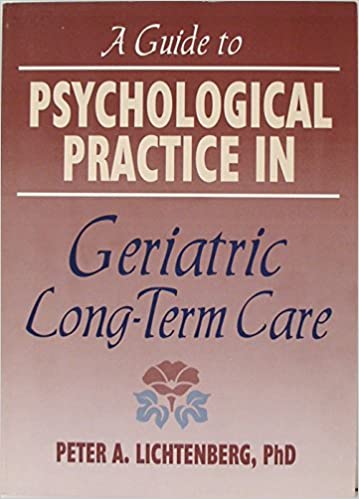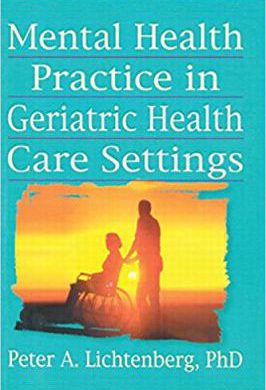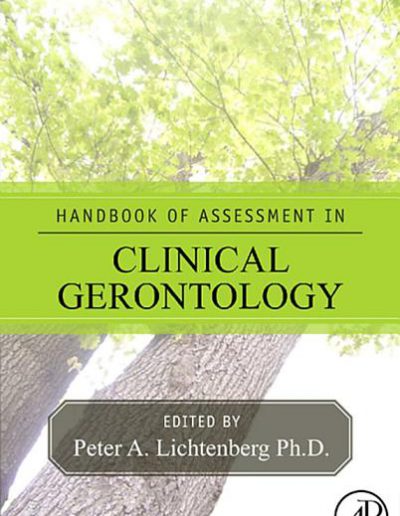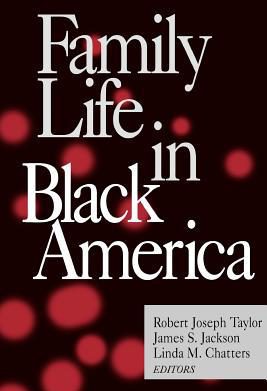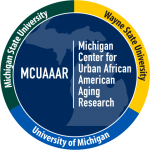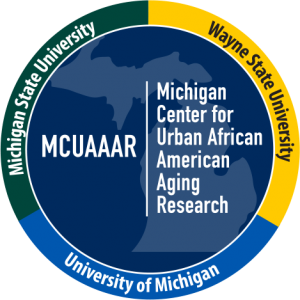
Michigan Center for Urban African American Aging Research
Books
Researching Black Communities: Methodological Guide
Edited by James S Jackson, Cleopatra H Caldwell, Sherrill L Sellers. Ann Arbor, MI: University of Michigan Press.
Aging in Black America
Edited by James S. Jackson, Linda M. Chatters, Robert Joseph Taylor. Newbury Park, CA: Sage Publications.
A Guide to Psychological Practice in Geriatric Long-Term Care
Peter A Lichtenberg. Haworth Press: Binghamton, NY.
Mental Health Practice in Geriatric Health Care Settings
Peter A. Lichtenberg. Haworth Press: New York, NY.
Handbook of Assessment in Clinical Gerontology
Edited by Peter A. Lichtenberg. Wiley Press: New York, NY.
Religion in the Lives of African Americans: Social, Psychological, and Health Perspectives
Taylor, R. J., Chatters, L. M., & Levin, J. Sage Publications.
Jackson, J. S. (Ed.). (1988). The Black American Elderly: Research on Physical and Psychosocial Health. New York: Springer Publishing Co.
Edited by James S. Jackson, Ph.D.
The purpose of this book is to present current knowledge on a relatively unexamined scientific subject–the black aging process–and to explore where future research efforts should be directed. This book is a compilation of papers that were presented during a two-day workshop, “Research on Again Black Populations,” health at the National Institutes of Health on September 25 and 26, 1986. The National Institute on Aging, the American Association of Retired Persons (AARP), and the Department of Health and Human Services’ Minority Health Office served as co-sponsors.
Table of Contents
Part 1: Introduction
Growing Old in Black America: Research on Aging and Black Populations – James S. Jackson
The Role of Black Universities in Research on Aging Black Populations – David Satcher
Part 2: Demography and Epidemiology of Older Black Adults
The Demography of Older Blacks in the United States – Ron C. Manuel
Cancer Prevention and Control in the Black Populations in the United States – Claudia R. Baquet
Social Determinants of the Health of Aging Black Populations in the United States – Jacquelyne Johnson Jackson
Social Participation in Later Life: Black-White Differences – Linda K. George
Part 3: Biological and Health Status of Older Black Adults
Dietary Intake and Nutritional Status of Older U.S. Blacks: An Overview – Norge W. Jerome
Diabetes and Obesity in Elderly Black Americans – Leslie Sue Lieberman
Aging and Hypertension among Blacks: A Multidimensional Perspective – Norman B. Anderson
Dementing Illness and Black Americans – F. M. Baker
Part 4: Social and Behavioral Processes among Older Black Adults
Subjective Well-Being among Older Black Adults: Past Trends and Current Perspectives – Linda M. Chatters
Aging and Supportive Relations among Black Americans – Robert Joseph Taylor
Aging and Hypertension among Blacks: A Multidimensional Perspective – Norman B. Anderson
Health-Seeking Behavior of Elderly Black – Tyson Gibbs
Health Attitudes/Promotions: The Black Elderly – James H. Carter
The Work, Retirement, and Disability of Older Black Americans – Rose C. Gibson
Part 5: Methodological Issues in Research on Older Black Adults
Survey Research on Aging Black Populations – James S. Jackson
The Design and Conduct of Case-Control Studies in Research on Aging Black Populations – Jerome Wilson
Clinical Trials and the Black Elderly: Issues and Considerations – Bettie Nelson Knuckles and Camilla A. Brooks
Part 6: Conclusions
Future Directions in Research on Aging Black Populations – James S. Jackson
Jackson, J.S. (Ed.) (1991). Life in black America. Newbury Park, CA: Sage Publications
Edited by James S. Jackson.
Relationships with family and friends, community life, religion, work, racial identity, political attitudes and participation, and physical and mental health are among the topics explored in this volume on Black Americans. It reports the findings from a survey that collected and analyzed data on social, psychological, economic, and political behaviors of Americans of African descent. This survey, the first to sample a truly representative cross-section of black people in America, was designed and conducted with a sensitivity to cultural influences never attempted before.
Table of Contents
Introduction – James S Jackson
Methodological Approach – James S Jackson
Neighborhood Life – Norweeta G Milburn and Phillip J Bowman
Family Life – Shirley Hatchett and Donna Cochran
Women and Men – Shirley Hatchett
Religious Life – Robert J Taylor and Linda M Chatters
Work-Life – Phillip J Bowman
Joblessness – Phillip J Bowman
Retirement – Rose C Gibson
Physical Health – Linda M Chatters
Mental Health – Harold W Neighbors
Race Identity – Wyane R Mc Cullough, Gerald Gurin and James S Jackson
Political Action – Ronald E Brown
Conclusion – James S Jackson
Jackson, J.S., Caldwell, C.H. & Sellers, S. (Eds.) (2012). Researching black communities: A methodological guide. Ann Arbor, MI: University of Michigan Press.
Edited by James S Jackson, Cleopatra H Caldwell, Sherrill L Sellers
Experts from a range of disciplines offer practical advice for conducting social science research in racial and ethnic minority populations. Readers will learn how to choose appropriate methods—longitudinal studies, national surveys, quantitative analysis, personal interviews, and other qualitative approaches—and how best to employ them for research on specific demographic groups. The volume opens with a brief introduction to the difficulty of defining a population and designing a research program and then moves to illustrative examples drawn from the contributors’ own studies of Blacks in the United States, the Caribbean, and South Africa. Case studies cover research on the media, mental health, churches, work, marital relationships, education, and family roles.
Table of Contents
- Conceptual and methodological challenges in studies of Black populations / James S. Jackson, Cleopatra Howard Caldwell, and Sherrill L. Sellers
- Researching “Black” educational experiences and outcomes: theoretical and methodological considerations / Carla O’Connor, Amanda Lewis, and Jennifer Mueller
- Crowded out?: the racial composition of American occupations / Darrick Hamilton and William A. Darity, Jr.
- Aging, physical health, and work and family role changes among African American women: strategies for conducting life-course research with African-American women / Letha A. Chadiha and Jewell F. Brazelton
- Research with high-risk African American infants and children: insights from a longitudinal study / Dolores G. Norton, Jacquelyn Vincson, and Melissa Wilhelm
- Studying marital relationships / Joseph Veroff and Terri L. Orbuch
- Conducting stress research in Black communities abroad: suggestions and methodological strategies for South African studies / Nikeea Copeland-Linder
- Methodological considerations in the study of work and occupations: the case of domestic workers in New York City / Sherrill L. Sellers, Colewick M. Wilson, and Michelle Harris
- The national survey of American life: innovations in research with ethnically diverse Black samples / James S. Jackson … [et al.]
- Conducting quantitative research with African American and Caribbean Black adult and adolescent populations: strategies for training interviewers with the national survey of American life / Julia F. Hastings, Heidi Kromrei, and Cleopatra Howard Caldwell
- Adjusting for and predicting non-response in a panel survey of African Americans / Monica L. Wolford and Myriam Torres
- Research with Black churches: lessons learned from the Black church family project / Cleopatra Howard Caldwell
- A certain kind of vision: revealing structure, process, and meaning in African American families / Andrea G. Hunter and Deborah J. Johnson
- Methods for the study of mental health in African American populations / Lonnie R. Snowden
- Using quantitative methods to study the impact of television exposure on the social and emotional development of African American children and adolescents / L. Monique Ward
- Regarding Black audiences: qualitative approaches to studying Black media consumption / Catherine Squires and Bambi Haggins.
Jackson, J. S., Chatters, L. M., & Taylor, R. J. (Ed.). (1993). Aging in Black America. Newbury Park, CA: Sage Publications.
Edited by James S. Jackson, Linda M. Chatters & Robert Joseph Taylor
Reflecting the major substantive issues related to psychological and social dimensions of aging, this book offers a broad perspective on a variety of issues relating to black Americans today. Among the topics examined are community, friends, and family; church and religion; health, social functioning, and well-being; group identity and political participation; and retirement and work.
Table of Contents
Roles and Resources of the Black Elderly – James S. Jackson, Robert Joseph Taylor, & Linda M. Chatters
Section I: Community, Friends, and Family
Neighborhoods, and Neighbor Relations – Rukmalie Jayakody
Crime Stress, Self-Esteem, and Life Satisfaction – John L. McAdoo
Gender, Marital, Familial, and Friendship Roles – Robert Joseph Taylor, Verna M. Keith, & M. Belinda Tucker
Intergenerational Support: The Provision of Assistance to Parents by Adult Children – Linda M. Chatters & Robert Joseph Taylor
Intimate Partnerships – Eleanor Engram & Shirley A. Lockery
Section II: Church and Religion
Religion and Religious Observances – Robert Joseph Taylor
Function and Supportive Roles of Church and Religion – Jacqueline M. Smith
Section III: Health, Social Functioning, and Well-Being
Physical Health – Mary McKinney Edmonds
Health Disability and Its Consequences for Subjective Stress – Linda M. Chatters
Mental Health and Help-Seeking Behavior – Ruth L. Greene, James S. Jackson, & Harold W. Neighbors
Section IV: Group Identify and Political Participation
Identity and Consciousness: Group Solidarity – Robert J. Smith and Michael C. Thornton
Group Consciousness and Political Behavior – Ronald E. Brown and Rupert W. Barnes-Nacoste
Demographic and Religious Correlates of Voting Behavior – Robert Joseph Taylor and Michael C. Thornton
Section V: Retirement and Work
The Black Americans Who Keep Working – Lerita M. Coleman
The Black American Retirement Experience – Rose C. Gibson
Section VI: Life Course of African Americans
Status and Functioning of Future Cohorts of African-American Elderly: Conclusions and Speculations – James S. Jackson, Linda M. Chatters, & Robert Joseph Taylor
Lichtenberg, P.A. (1994). A Guide to Psychological Practice in Geriatric Long Term Care. Haworth Press: Binghamton, NY.
Peter A Lichtenberg. Haworth Press: Binghamton, NY.
Here is a helpful guide for practitioners who work in long-term care settings. A Guide to Psychological Practice in Geriatric Long-Term Care highlights and describes assessment tools and interventions for use with older adults in residential facilities. It is written from a pragmatic view of elder care that fosters the growth of geriatric psychology and views aging dynamically, as a developmental phase with its own challenges, opportunities, and responsibilities. A primer for health professionals in long-term care, this book explains new intervention strategies practitioners can apply to their own residents and helps administrators organize and deliver care in an efficient and substantive manner.
A Guide to Psychological Practice in Geriatric Long-Term Care is divided into two sections. The first presents an integrative model of psychological services as part of geriatric care. It discusses conceptual issues and provides practical advice on how geriatric psychology and other geriatric disciplines can blend into a diversified and rich clinical environment for the caring of older adults. The second part focuses on important and often ignored clinical issues in long-term care such as alcohol abuse, sexuality, psychotherapeutic intervention, and caregiver issues. It urges psychologists to use their theoretical backgrounds and clinical training to explore new foci of care. In both sections, pertinent literature is reviewed and case vignettes illustrate ideas and concepts.
Other topics discussed in this book include neuropsychology, effective use of paraprofessionals, the use and training of interdisciplinary teams, behavioral medicine, family caregiving, and integrated treatment planning. Intrinsically a multidisciplinary book, A Guide to Psychological Practice in Geriatric Long-Term Care is an ideal resource for psychologists, social workers, counselors, nurses, nursing home administrators, and students in these fields who are interested in providing effective care for older adults. The author invites these professionals to see how psychology can enrich their respective clinical practices.
Lichtenberg, P.A. (1998). Mental Health Practice in Geriatric Healthcare Settings. Haworth Press: New York, NY
Peter A Lichtenberg. Haworth Press: Binghamton, NY.
Mental Health Practice in Geriatric Health Care Settings emphasizes the major research and clinical findings realized in five years of research on mental health issues in older urban medical patients, many of whom represent minority groups. Chapters cover the high comorbidity of health and mental health problems in geriatric patients, neuropsychological (or cognitive) assessment, depression, alcohol abuse in health care settings, emerging behavioral medicine issues, and family relations and their tie to medical settings. As a practitioner, you’ll find this book helps your practice by representing the first assessment and treatment techniques normed and validated on minority elderly. If you’re a professional working in the mental health system, you’ll see how to expand your services to health care markets.
Mental Health Practice in Geriatric Health Care Settings devotes three chapters to neuropsychological assessment–first, a review of major principles; second, a new test battery for minorities; and third, an extensive review on how to use test results in clinical decision making. Other chapters provide valuable information on:
- the analysis of outcomes for one thousand 60–103-year-olds
- a new validated behavioral treatment method for depression
- methods of detection and treatment of alcohol abuse
- emerging issues in behavioral medicine, including competency assessments; anxiety and pain disorders; and shaping the referral process
- family relations and health care, including caregiving and nursing home placement
- nursing home consultation and survival strategies in health care systems
As Author Peter A. Lichtenberg describes in the Introduction, each chapter in Mental Health Practice in Geriatric Health Care Settings is multidisciplinary, empirically and statistically investigated, and focused upon urban elderly. “In addition, the major objectives are to provide clinicians with new understandings and new assessment and treatment knowledge to utilize in their practices. Finally, this book is hoped to provide clinicians [with] information about emerging trends in the field, and effective strategies for practice in healthcare settings.”
Table of Contents
- Introduction: The Links Between Physical and Mental Health
- Chapter 1: Overview
- Chapter 2: Influence of Cognition on Health Outcomes
- Chapter 3: The Role of Depression in Geriatric Health Outcomes
- Chapter 4: Perspectives on Cognition in Normal Elderly and in Those with Alzheimer’s Disease
- Chapter 5: The Normative Studies Research Project Test Battery
- Chapter 6: Utilizing the NSRP Test Battery
- Chapter 7: Behavioral Treatment of Geriatric Depression in Health Care Settings
- Chapter 8: Detection and Treatment of Alcohol Abuse
- Chapter 9: Emerging Areas in Geriatric Health Care Practice
- Chapter 10: Mental Health Practitioners’ Survival of Health Care Changes
Lichtenberg, P.A. (2010) Handbook of Assessment in Clinical Gerontology: 2nd edition. Elsevier: New York.
Edited by Peter A. Lichtenberg
New trends in mental healthcare practice and a rapid increase in the aged population are causing an explosion in the fields of clinical gerontology and geropsychology today. This comprehensive second edition handbook offers clinicians and graduate students clear guidelines and reliable tools for assessing general mental health, cognitive functioning, functional age, psychosocial health, comorbidity, behavior deficits, and more. Psychopathology, behavioral disorders, changes in cognition, and changes in everyday functioning are addressed in full, and a wide range of conditions and disorders common to this patient population are covered. Each chapter provides an empirical review of assessment instruments, assessment scales in their totality, a review of how these instruments are used with and adapted for different cultural groups, illustration of assessments through case studies, and information on how to utilize ongoing assessment in treatment and/or treatment planning. This combination of elements will make the volume the definitive assessment source for clinicians working with elderly patients.
Table of Contents
Section I: Psychopathology in Later Life
1. Depression and Bereavement, Barry Edelstein (W Virginia U, USA)
2. Anxiety Disorders, Cheryl N. Carmin (U Illinois Chicago, USA)
3. Assessment for Psychotherapy, Linda Dougherty (Virginia Commonwealth Univ, USA)
4. Personality Disorders
5. Psychosis and Serious MI, Linda & Donald Hay (Univ Colorado, USA)
6. Dementia, Kathryn Perez Riley (U Kentucky, USA)
7. Delirium, Donna K. Broshek (U Virginia, USA)
8. Functional and Behavioral Health, Michael J. Salamon (Adult Devel Center, NY, USA)
9. Elder Abuse and financial fraud
10. Caregiver strain and burden
11. Family functioning to support older adult
Section II: Behavioral Disorders
12. Alcohol Problems, Kristen Lawton Barry(U Michigan Ann Arbor, USA)
13. Sexual Function and Dysfunction, Antonette & Robert Zeiss (VA Palo Alto Health Care System, USA)
14. Nutritional Status
15. Agitation, Lori Schindel Martin (McMaster U, Canada)
16. Sleep, Tracy Treverrow (Chaminade U, USA)
17. Rehabilitation Potential, Kathleen Sitley Brown (Health Psych Assoc, USA)
18. Treatment adherence for chronic disease behaviors/lifestyles
Section III: Cognition
19. Geriatric Neuropsychology, Asenath La Rue (U New Mexico, USA)
20. Screening and Brief Batteries, Susan E. MacNeill (Wayne State U, USA)
21. Cognitive Assessment in late stage dementia, Elisabeth Koss (Case Western, USA)
22. Personal desires of those with dementia, metacognition
23. Cognitive training
Section IV: Everyday functioning
24. Competency and Decision-Making Capacity, Jennifer Moye (Harvard Med, USA)
25. Household and Neighborhood safety, mobility
26. Pain, Raymond C. Tait (St Louis U School of Med, USA)
27. Driving, Linda A. Hunt, Katherine Weston (Maryville U, USA)
28. Assessing health care functioning/integrated care
Neighbors, H.W., & Jackson, J.S. (Eds.) (1996). Mental health in black America. Thousand Oaks, CA: Sage Publications.
Edited by Harold W. Neighbors and James S. Jackson
Celebrating the resilience of African Americans and their ability to cope with stress in the face of prejudice and discrimination, Mental Health in Black America explores how the quality of life among black Americans relates to behavioral health problems and diseases and examines the strategies blacks use to cope with the problems they face living in the United States. This unique edited volume details the self-reported stress of being black in America while documenting the cultural resources African Americans draw upon to overcome adversity and maintain a positive, healthy perspective on life. Beginning with a discussion of black life satisfaction and the broad psychological and sociological factors that affect it, contributors focus on how psychosocial factors contribute to such health problems as alcoholism and hypertension. Concluding with a thorough look at how blacks attempt to solve life problems, this volume highlights such strategies as prayer, avoidance, and active problem solving, as well as help-seeking from others such as family, community mental health providers, and law enforcement agencies. Mental Health in Black America is an insightful, informative volume that will help students and professionals in the fields of ethnic studies, psychology, social work, and public policy gain a clearer understanding and appreciation of the psychological dimension of the African American experience in the United States.
Table of Contents
Foreword- Gerald Gurin
Mental Health in Black America- Harold W Neighbors and James S Jackson
Psychosocial Problems and Help-Seeking Behavior
A Model-Free Approach to the Study of Subjective Well-Being- Carolyn B Murray and M Jean Peacock
Stress and Residential Well-Being- Gayle Y Phillips
Problem Drinking, Chronic Disease and Recent Life Events- Isidore Silas Obot
An Analysis of Stress Denial- Rhoda E Barge Johnson and Joan E Crowley
Marital Status and Mental Health- Diane R Brown
The Association between Anger-Hostility and Hypertension- Ernest H Johnson and Larry M Gant
Coping with Personal Problems- Clifford L Broman
Kin and Nonkin as Sources of Informal Assistance- Robert Joseph Taylor, Cheryl Burns Hardison and Linda M Chatters
Predisposing, Enabling and Need Factors Related to Patterns of Help-Seeking among African American Women- Cleopatra Howard Caldwell
Mental Health Symptoms and Service Utilization Patterns of Help-Seeking among African American Women- Vicki M Mays, Cleopatra Howard Caldwell and James S Jackson
The Police- Patricia A Washington
A Reluctant Social Service Agency in the African American Community
Changes in African American Resources and Mental Health- James S Jackson and Harold W Neighbors
Taylor, R. J., Chatters, L. M.,. & Levin, J. S. (2004). Religion in the Lives of African Americans: Social Psychological and Health Perspectives. Newbury Park: Sage.
Robert Joseph Taylor, Linda M. Chatters, Jeff Levin.
The religious faith of African Americans has many avenues of expression. Consequently, there has been a long-standing interest in the nature, patterns, and functions of religion in the lives of this particular ethnic group. African American religious life, in all its forms, is a vibrant, creative, resourceful testament to the power of faith to uplift and sustain in the face of prejudice, discrimination, and exclusion.
Religion in the Lives of African Americans: Social, Psychological, and Health Perspectives examines many broad issues including the structure and sociodemographic patterns of religious involvement; the relationship between religion and physical and mental health and well-being; the impact of church support and the use of ministers for personal issues; and the role of religion within specific subgroups of the African American population such as women and the elderly. Authors Robert Joseph Taylor, Linda M. Chatters, and Jeff Levin reflect upon current empirical research and derive conclusions from several wide-ranging national surveys, as well as a focus group study of religion and coping.
Table of Contents
Foreword – James S. Jackson
Introduction
African American Religious Participation
The Frequency and Importance of Prayer
Prayer as a Source of Coping
Use of Ministers for Personal Problems
Church Members as a Source of Social Support
Negative Interaction Among Church Members
Impact of Religion on Physical Health
Impact of Religion on Mental Health and Well-Being
Coclusions and Implications
Taylor, R.J., Jackson, J.S., & Chatters, L.M. (Eds.) (1997). Family life in black America. Thousand Oaks, CA: Sage Publications.
Edited by James S. Jackson, Linda M. Chatters & Robert Joseph Taylor
Over the past 20 years, African American families have undergone tremendous changes, both demographically and socially. During this time, most of the studies of black families have focused on problems, such as out-of-wedlock births, single-parent families, and childhood poverty. While an accurate appreciation of the challenges confronting black families is important and needed, a “problem focus” tends to offer a narrow, negative view and restricts the consideration of other important issues affecting families. Family Life in Black America moves away from this deficit perspective and the result is enlightening both in its comprehensive reach and systematic scholarship. Readers of this volume will be pleased with the wide range of issues dealt with in this volume, including maturation, mate selection, sexuality, procreation, infancy, adulthood, adolescence, gender issues, young adulthood, cohabitation, parenting, grandparenting, and aging. Each article is firmly grounded in empirical data, based on, but not limited to, the National Survey of Black Americans (NSBA). A fresh aspect of this book is the amount of diversity it reveals within African American families and the forces that shape, limit, and enhance them. Both uplifting and informative, Family Life in Black America is truly unique in its field and will be used by professionals and students in ethnic studies, family studies, social work, psychology, research methods, and gerontology.
Table of Contents
Foreword- Robert Joseph Taylor, Linda M Chatters and James S Jackson
Introduction- Robert Joseph Taylor, Linda M Chatters and James S Jackson
Recent Demographic Trends in African American Family Structure- Robert Joseph Taylor et al
The Effects of Mate Availability on Marriage among Black Americans: A Contextual Analysis- K Jill Kiecolt and Mark A Fossett
Gender, Age and Marital Status as Related to Romantic Involvement among African American Singles- M Belinda Tucker and Robert Joseph Taylor
Life Stress and Psychological Well-Being among Married and Unmarried Blacks- Verna M Keith
Religious Involvement and the Subjective Quality of Family Life among African Americans- Christopher G Ellison
Multiple Familial-Worker Role Strain and Psychological Well-Being- Ruby L Beale
Moderating Effects of Coping Resources among Black Americans Parents- Robert Joseph Taylor and Sherrill L
Sellers Informal Ties and Employment among Black Americans- Clifford L Broman
Families, Unemployment and Well-Being- Rukmalie Jayakody and Linda M Chatters Differences among African American Single Mothers
Marital Status, Living Arrangements, and Family Support-
Childrearing, Social Support and Perceptions of Parental Competence Among African American Mothers- Cleopatra Howard Caldwell and Lilah Koski
Strategies of Racial Socialization Among Black Parents: Mainstream, Minority & Cultural Messages- Michael C Thornton
Instrumental and Expressive Family Roles Among African American Fathers- Phillip J Bowman and Tyrone A Forman
Family Roles and Family Satisfaction Among Black Men- Robert Joseph Taylor and Waldo E Johnson, Jr
Living Arrangements of African-American Adults Variations by Age, Gender and Family Status- Andrea G Hunter
Husbands, Wives, Family, and Friends: Sources of Stress, Sources of Support- H W Neighbors
Changes Over Time in Support Network Involvement among Black Americans- Robert Joseph Taylor, James S Jackson, and Linda M Chatters

